The Asus ROG Swift PG27UQ G-SYNC HDR Monitor Review: Gaming With All The Bells and Whistles
by Nate Oh on October 2, 2018 10:00 AM EST- Posted in
- Monitors
- Displays
- Asus
- NVIDIA
- G-Sync
- PG27UQ
- ROG Swift PG27UQ
- G-Sync HDR
SDR Color Modes: sRGB and Wide Gamut
Pre-calibration/calibration steps of the monitor is done with SpectraCal’s CalMAN 5 suite. For contrast and brightness, the X-Rite i1DisplayPro colorimeter is used, but for the actual color accuracy readings we use the X-Rite i1Pro spectrophotometer. Pre-calibration measurements were done at 200 nits for sRGB and Wide Gamut with Gamma set to 2.2.
The PG27UQ comes with two color modes for SDR input: 'sRGB' and 'Wide Gamut.' Advertised as DCI-P3 coverage, the actual 'Wide Gamut' sits somewhere between DCI-P3 and BT.2020 HDR, which is right in line with minimum coverages required by DisplayHDR 1000 and UHD Premium. That being the case, the setting isn't directly calibrated to a color gamut, as opposed to sRGB.
Out-of-the-box, the monitor defaults to 8 bits per color, which can be changed in NVIDIA Control Panel. Either way, sRGB accuracy is very good, as the monitor comes factory-calibrated. To note, 10bpc for the PG27UQ is with dithering (8bpc+FRC).
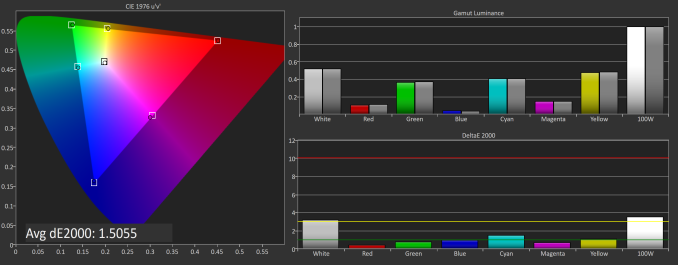
SpectraCal CalMAN sRGB color space for PG27UQ, with out-of-the-box default 8bpc (top) and default with 10bpc (bottom)
In 8bpc or 10bpc, average delta E is around 1.5, which corresponds with the included factory calibration result of 1.62; for reference, for color accuracy a dE below 1.0 is generally imperceptible and a dE below 3.0 is considered accurate.
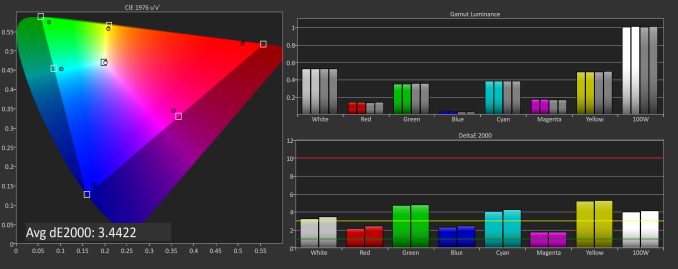 SpectraCal CalMAN DCI-P3 (above) and BT.2020 (below) color spaces for PG27UQ, on default settings with 10bpc and 'wide color gamut' enabled under SDR Input
SpectraCal CalMAN DCI-P3 (above) and BT.2020 (below) color spaces for PG27UQ, on default settings with 10bpc and 'wide color gamut' enabled under SDR Input
The 'wide gamut' options are not mapped to either DCI-P3 or BT.2020, sitting somewhere in between, but then again, it doesn't need to be as a professional or prosumer monitor would.
Grayscale and Saturation
Looking at color accuracy more throughly, we look at greyscale and saturation readings with respect to the sRGB gamut. The dips in gamma aren't perfect, and the whitepoints are a little on the warm side.
 SpectraCal CalMAN sRGB color space grayscales with out-of-the-box default 8bpc (top) and default with 10bpc (bottom)
SpectraCal CalMAN sRGB color space grayscales with out-of-the-box default 8bpc (top) and default with 10bpc (bottom)
The saturation numbers are better, and in fact the dE is around 1.5 to 1.4, which is impressive for a gaming monitor.
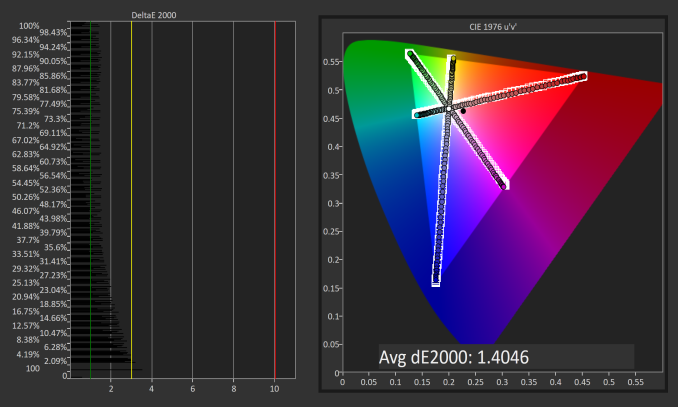 SpectraCal CalMAN sRGB color space saturation sweeps for PG27UQ, with out-of-the-box default 8bpc (top) and default with 10bpc (bottom)
SpectraCal CalMAN sRGB color space saturation sweeps for PG27UQ, with out-of-the-box default 8bpc (top) and default with 10bpc (bottom)
Gretag Macbeth (GMB) and Color Comparator
The last color accuracy test is the most thorough, and again the PG27UQ shines with dE of 1.53 and 1.63
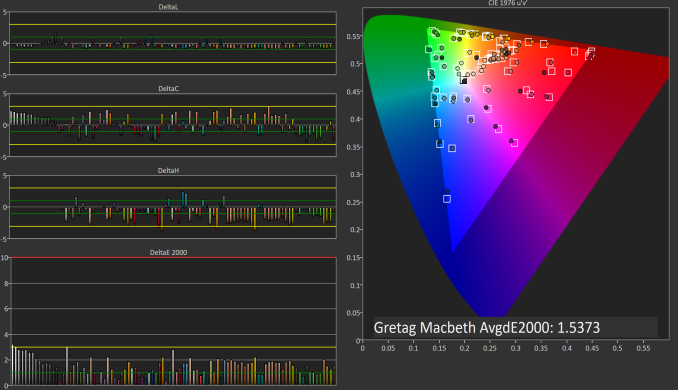 SpectraCal CalMAN sRGB color space GMB for PG27UQ, with out-of-the-box default 8bpc (top) and default with 10bpc (bottom)
SpectraCal CalMAN sRGB color space GMB for PG27UQ, with out-of-the-box default 8bpc (top) and default with 10bpc (bottom)
Considering that this monitor was not designed for professional use, it's very calibrated out-of-the-box for gamers, and there's no strong concern for calibration. If anything, users should just be sure to select 10bpc in the NVIDIA Control Panel, but even then most games use 8bpc anyhow.

 SpectraCal CalMAN sRGB relative color comparator graphs for PG27UQ, with out-of-the-box default 8bpc (top) and default with 10bpc (bottom). Each color column is split into halves; the top half is the PG27UQ's reproduction and the bottom half is the correct value
SpectraCal CalMAN sRGB relative color comparator graphs for PG27UQ, with out-of-the-box default 8bpc (top) and default with 10bpc (bottom). Each color column is split into halves; the top half is the PG27UQ's reproduction and the bottom half is the correct value


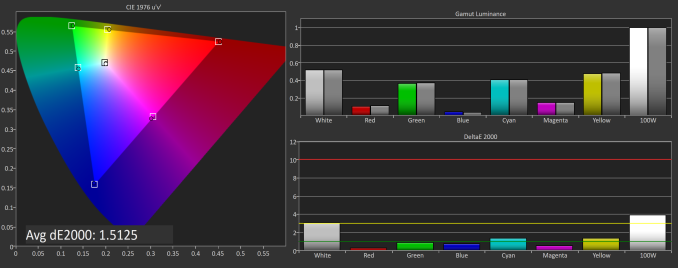
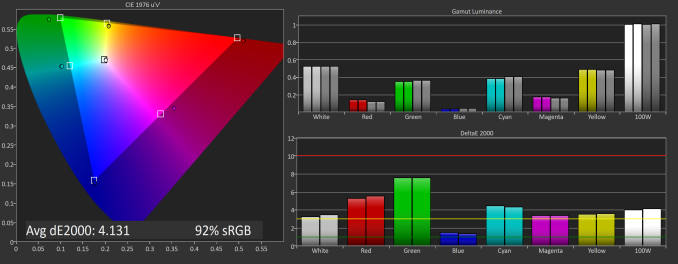
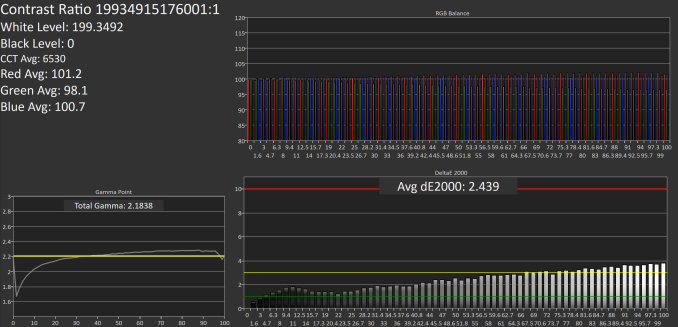
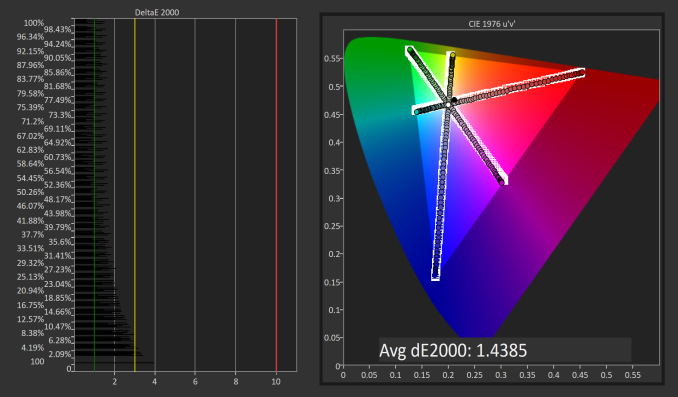
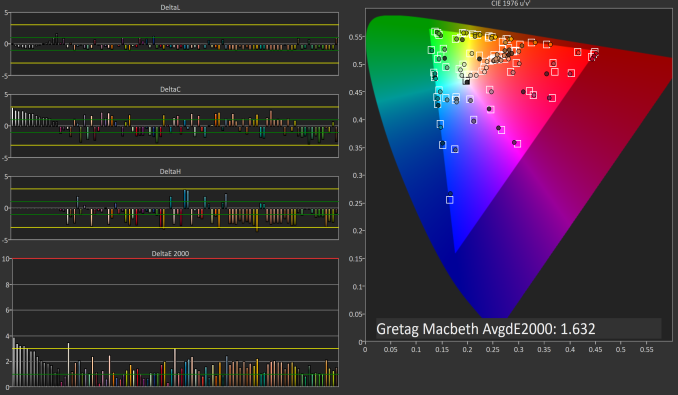








91 Comments
View All Comments
FreckledTrout - Tuesday, October 2, 2018 - link
AUO have stated it lands this fall so should be very soon. They made it sound like they will have a shipping monitor by the end of 2018 albeit who really knows but im sure its under 1 year away at this point.Can Google: "AUO Expects to Launch Mini LED Gaming Monitor in 2H18"
imaheadcase - Wednesday, October 3, 2018 - link
Don't keep hopes hope, remember this monitor in this very review was delayed 6+ monthsLolimaster - Tuesday, October 2, 2018 - link
384 zones is just CRAP, you only find that number of zones on low end cheapo TV's with FALD just o be a bit more "premium". For that price is should have 1000 AT LEAST.Seems we will need to wait for LCD with minileds to actually start seeing monitors with 5000+zones.
know of fence - Tuesday, October 2, 2018 - link
Consoles started to push that 4K / HDR nonsense and now the monopoly provides a monitor to match for the more money than sense crowd. The obscure but sensible strobing backlight / ULMB got sacrificed for the blasted buzzwords and Gsync. Is it because the panel is barely fast enough for Gsync or is it a general shift in direction, doubling down on proprietary G-stink and the ridiculously superfluous 4K native. Is it because with failing VR, high frame rates are off the table completely?Is there any mention on how 1920x1080 looks on that monitor (too bad), because the pixel density is decidedly useless and non standard. But scaled down to half it could be 81.5 ppi and this thing can actually be used to read text.
godrilla - Tuesday, October 2, 2018 - link
$1799 at micr1 fyi!godrilla - Tuesday, October 2, 2018 - link
Microcenter*Hectandan - Tuesday, October 2, 2018 - link
"the most desired and visible aspects of modern gaming monitors: ultra high resolution (4K)"No it's not. At least on Windows where UI scaling still sucks. At least on "slow" graphics card like 2080 Ti where 4K doesn't run 144fps. And 4K monitors can't do 1440p natively, so a huge deal breaker.
Zan Lynx - Wednesday, October 3, 2018 - link
If you had a graphics card that could always run 144 Hz then you would have no need for GSync.imaheadcase - Wednesday, October 3, 2018 - link
Why would you care about scaling for gaming? Besides, plenty of 3rd party apps to correct windows bullshit.Hectandan - Thursday, October 4, 2018 - link
No I don't care about scaling in games, but I do care about 144fps in games. Only possible in 4K with SLI 2080 Ti and good game SLI support. Plenty of games don't.Also plenty of 3rd party apps not correcting Windows bullshit, and I gain no extra working space if I do scale.
Simply too many downsides and too little benefit.